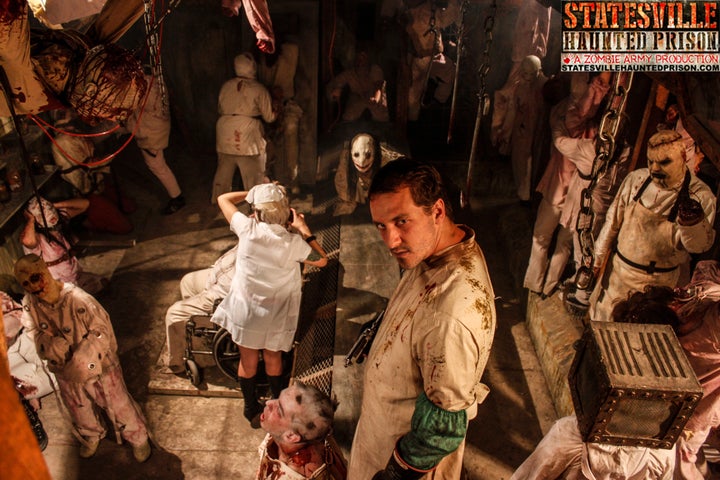
CHICAGO ― Each fall, thrill-seeking visitors show up to one of the most infamous maximum security prisons in the United States, only to be turned away.
Five minutes away, the loved ones of prison inmates send mail and phone calls to Paul Siegel’s farm, hoping to find out about commissary accounts and prisoner release dates.
The Halloween season is peak time for confusion between Stateville Correction Center and Statesville Haunted Prison, two sites located a stone’s throw from each other roughly 40 miles southwest of Chicago.
That tourists easily mistake one for the other has been a boon to Siegel since he opened the attraction on his farm in 1996. The site is consistently named among the best haunted houses in the state, and for Siegel’s livelihood as a farmer, “it’s a very big piece of the puzzle,” he said.
But the proximity is troubling to others ― namely, prison reform advocates and those who work in restorative justice.
Critics say these kinds of prison-themed haunted amusements reinforce existing stigmas that make it hard for inmates to reintegrate into society once they’re released.
“It’s indirect damage, that’s what’s insidious about it. It affects us on a level that’s really hard to be conscious of,” said Kimberley Moe, who teaches a course on restorative justice at Stateville as part of the Inside-Out prison exchange program at DePaul University. The course is held inside Stateville itself, with DePaul undergrads and inmates studying side by side for the term.
Jamal, one of the program’s students and an inmate at Stateville, said he feels conflicted about the haunted prison being so close to his real-life prison. In a letter to The Huffington Post, Jamal called the attraction a “complete contradiction of our reality.”
“You profit off the sorrows of men who are more than the sum of their mistakes,” he wrote.
Andre, another student from Stateville, wrote that visitors likely see the attraction as just harmless entertainment.
“They don’t realize they’re being fed some of the worst, most sensationalized versions of prisons and prisoners,” he said.
Old prisons that no longer house inmates can experience a wide variety of second acts. Some become popular filming locations, like the Tennessee State Prison in Nashville that’s been used in movies like “The Green Mile” and “The Last Castle.” Others, like Alcatraz in San Francisco, become museums and historical sites. Increasingly, as the Marshall Project noted in July, old prisons are becoming so-called “dark tourism” sites that host haunted houses and ghost tours.
Rutgers University Professor Michael Welch, who studies penal tourism and wrote the 2015 book Escape to Prison, says haunted prisons and similar attractions offer an alluring mix of frightening authenticity and safe distance.
“A haunted prison has a gravitational pull because people want to be on an actual site where horrible things have happened, but they also want safe contact,” he said. “If you said ‘you can come into this haunted prison, but only half of you will be allowed to leave,’ well, that’d be the end of it.”

Housing an attraction at an actual prison, or at least near one, is crucial in providing what Welch calls “sited-ness” ― a kind of authenticity that can’t be replicated just anywhere.
Statesville Haunted Prison gives a false sense of sited-ness since it was never a real prison to begin with, Welch said. Even so, having an actual prison nearby adds an extra dimension to it.
But since the haunted attraction is highly dramatized and the scenarios it depicts are fantastical and embellished, Welch doesn’t believe there’s much negative impact.
The haunted prisons have “no authenticity” with regard to actual prisons ― something that Welch says most visitors understand.
Alan Mills disagrees. Mills, the executive director of the Chicago-based Uptown People’s Law Center, which advocates for prisoner rights, says that sensational portrayals of prisons and inmates do a disservice to everyone ― not just the incarcerated.
“Done right, like the Eastern State Penitentiary, it can serve as an excellent means of opening up a world that is usually closed, exposing just how inhumane prisons are,” Mills told HuffPost in a Facebook message.
But haunted house-style attractions meant only to thrill or scare “add nothing to our understanding of prisons” and are “dehumanizing,” he said.
“It encourages people to think of prisoners as scary monsters, rather than people exactly like everyone else ― except they had fewer choices, and (may have) made a bad decision in their lives,” Mills said. “They encourage people to accept prison conditions which constitute torture, by getting people to think of prisoners as less than human.”

Apart from an incident in the 1940s when two escaped inmates allegedly stole a family car at knifepoint, Siegel, 59, said Stateville’s closeness had never had much of an effect on the farm one way or another, until he opened the haunted prison to support the farm’s finances.
Twenty years ago, there were fewer haunted houses around, and the ones that existed typically offered a melange of pop-culture movie monsters and references to famous historical events. Today, haunted houses are an industry worth nearly half a billion dollars, according to the Haunted Attraction Association.
“I wanted to have [a] themed haunted house that was scary but was also very different than what most of the slasher-movie type things would be produced,” Siegel said.
Stateville holds a number of historical distinctions. It was the execution site of serial killer John Wayne Gacy and the home of the last functioning panopticon, or “roundhouse” unit, in the country. Earlier this month, Illinois Gov. Bruce Rauner (R) announced he was closing down Stateville’s panopticon, calling it dangerous and antiquated.
“Of course I wanted use the notoriety of having a very scary maximum security [prison] next to the place,” Siegel said, explaining his decision to give his haunted prison attraction a name almost identical to Stateville’s.
Statesville Haunted Prison’s conceit is simple enough: The “guards” have fled, and a cast of deranged “inmates” have taken over. The attraction is for adults only and takes about 45 minutes to navigate, although Siegel says not everyone is brave enough to make it through.
About 160 actors work the haunted house, including star players with intricate makeup and detailed backstories. One character is a mental health patient whose history includes “the murder and mutilation of 6 teenagers and 1 police officer” with “hands and feet” as the weapon of choice.
“We’re not glorifying anything or showing any mayhem,” said Siegel, who notes that the attraction never depicts torture or murder. “We’re not showing guards getting taken over or killed or anything like that.”
Siegel also points out that the prison is just one of his farm’s holiday offerings. Most are decidedly more family-friendly, like pumpkin festivals, hayrides and corn mazes. But the haunted prison is crucial to the farm’s finances, he says. And people enjoy it.
Moe, the DePaul professor, acknowledged that the issue is not black and white.
“I understand that people need to live and need to make money,” she said. “It’s not easy to make ends meet on a farm.”
While some of the Stateville students say they’re deeply offended and frustrated by the haunted prison, others simply shrug it off as a product of capitalism.
Moe is aware of the challenges her Stateville students will face if and when they’re released. She said that some of them share “a kind of worn down-ness that no matter which way they turn, they’re met with these real negative things.”
An estimated 95 percent of state correctional inmates, like those at Stateville, will return to society at some point.
More than a dozen of the Stateville students wrote that their biggest desire is to be productive when they’re released, and to be able to contribute to society instead of being shunned.
“Just because you’ve been touched by the correctional system,” Moe said, “that does not make you a monster.”

